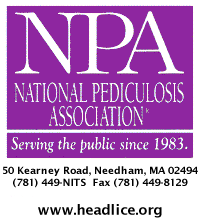March 29, 2002 Public Information and Records Integrity Branch (PIRIB) Information Resources and Services Division (7502C) Office of Pesticide Programs Environmental Protection Agency 1200 Pennsylvania Avenue NW Washington, DC 20640 Docket Control
Number OPP-34239B - Revised Lindane Risk Assessments
The National Pediculosis Association (NPA) supports the comments submitted to the EPA docket by the Tri-TAC Chair David Williams, state of California on March 29, 2002. It is the NPA’s mission to protect children from the misuse and abuse of pesticides used for treating them for head lice and scabies and it is accepted knowledge that normal use of these pesticidal treatments is misuse. Lindane may be regarded as a highly regulated pesticide, but its use by parents on their children and themselves is anything but controlled. We first appealed to the U.S. Food and Drug Administration for a ban of lindane in 1983 for these reasons. It is predictable that inordinate amounts of lindane will be purchased and applied to children’s scalps and skin both in the home, the hospital and other institutional settings. Lindane is not 100% effective against pediculosis and scabies, contributing to organism resistance and chronic human infestations. Lindane applied to the scalps and skin of children and families puts them at substantial risk of its harmful effects even before consideration of additional exposures after it has been re-routed via the sewer system back to a child’s water, air and food. We find that risk assessment for lindane insufficiently considers the children, the population most vulnerable to pesticides in general. Nor do assessments fully consider the cumulative and unpredictable combined effects with numerous other potentially harmful pesticides that are in their lives but cannot be measured or prevented. U.S. Government agencies must resolve to work cooperatively with all available resources to protect the public from the ill effects of lindane and the chemical agents used to produce it. California’s unique ability to directly associate and measure lindane levels in water resulting from its use as a pharmaceutical is a phenomenal scientific opportunity on which to build. Moreover, the positive documented impact of education and prevention strategies utilized by the Sanitation District of Los Angeles County and the National Pediculosis Association’s Lindane Reduction Project, demonstrates that success in protecting human health and our environments from lindane can be cost-effective, immediate and far reaching. In the U.S. cancer kills more children under the age of 15 than any other disease, including AIDS. It is estimated that 8,000 new cases of childhood cancer will be diagnosed in the US each year. Acute leukemia, a cancer already associated with lindane, accounts for the highest percentage. Twenty three million children under the age of 18 suffer from learning disabilities as reported by the Learning Disabilities Association of America. Behavioral disorders such as hyperactivity and Attention Deficit Disorder are considered signs of low-level chemical exposure and now affect one out of every six U.S. children. We can’t remove every potentially harmful chemical exposure from a child’s life, making it imperative that we remove those that we can. Obviating lindane as a pharmaceutical in the EPA’s risk assessment puts the EPA in a position of denying the most attainable protection to the most vulnerable population, … from one of the most toxic pesticides of them all. Sincerely, Deborah Z. Altschuler President National Pediculosis Association 50 Kearney Road Needham, MA 02494 781-449-6487 Submitted electronically to EPA 3-29-02
“Our future will depend on the wisdom not to replace one poison with another.” |
